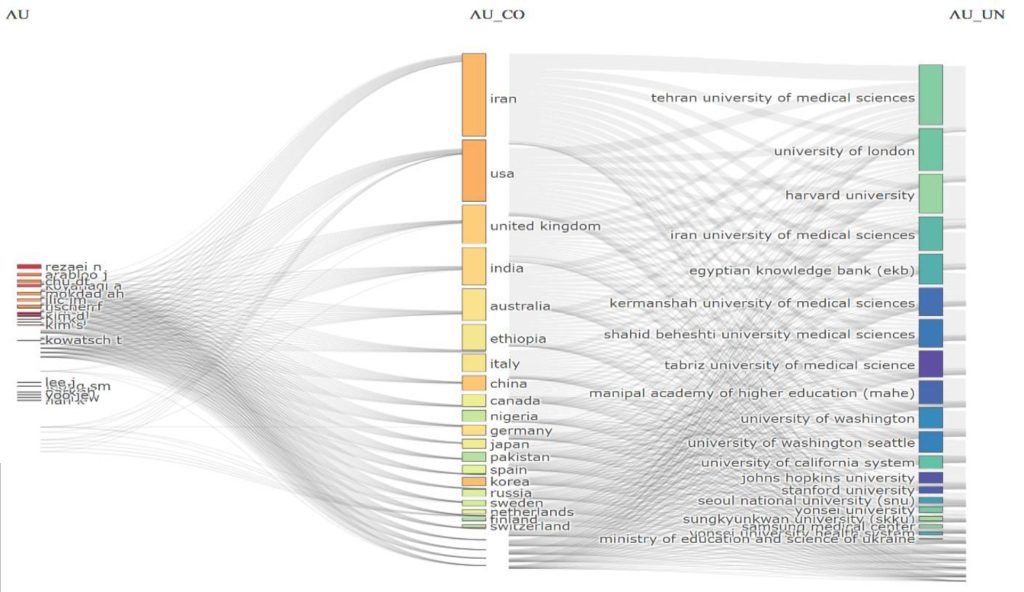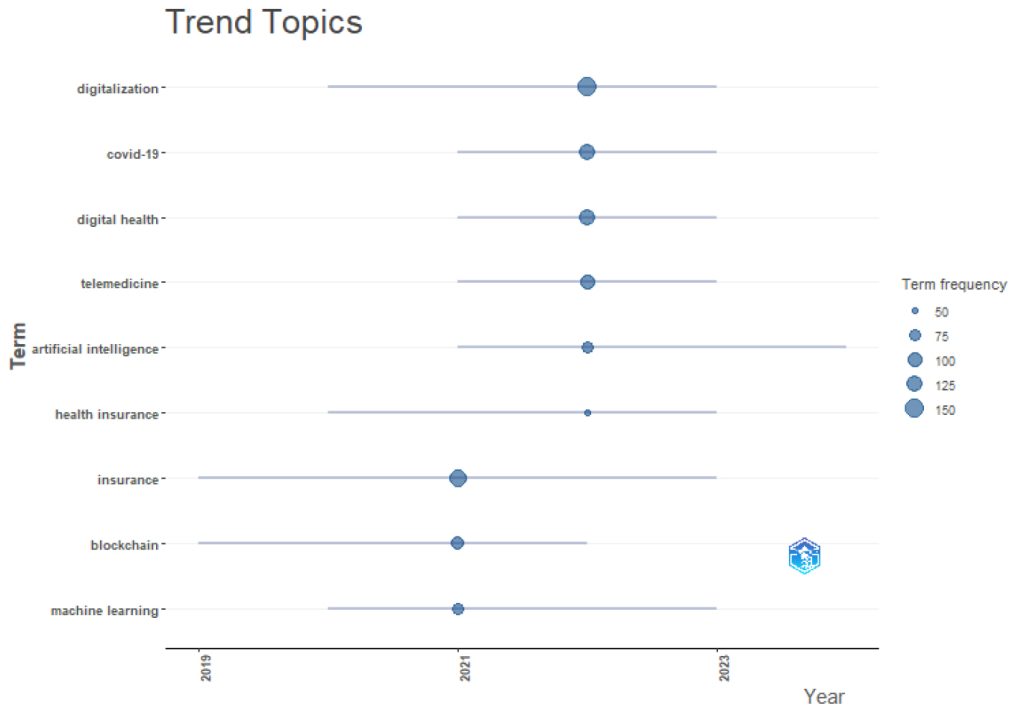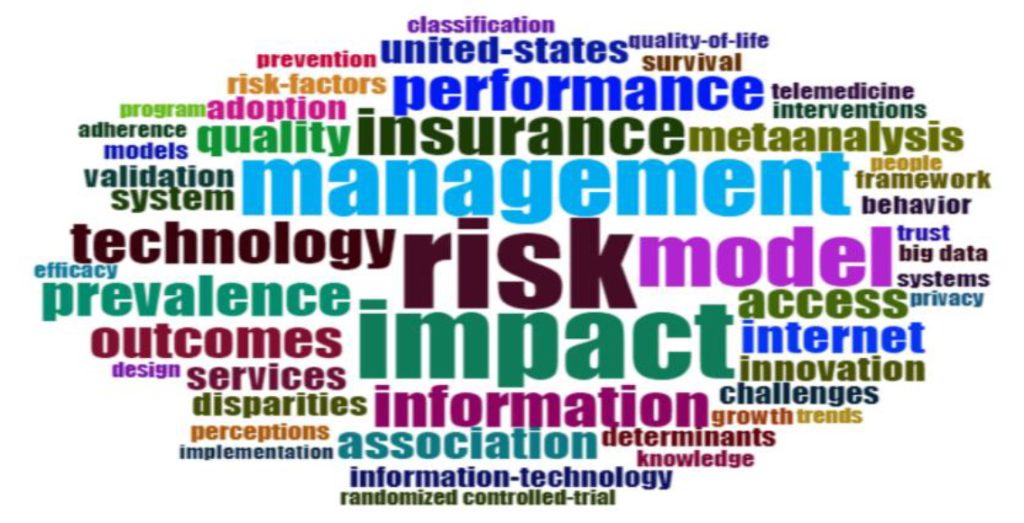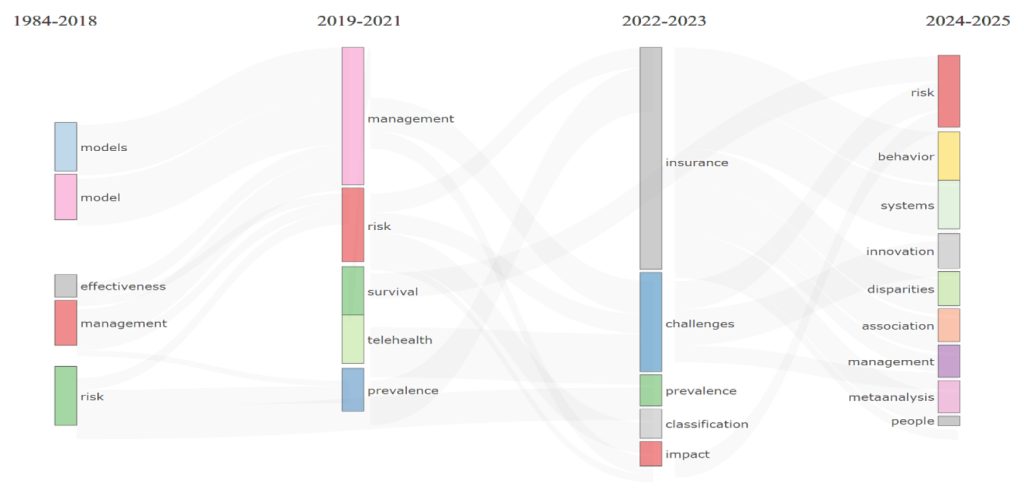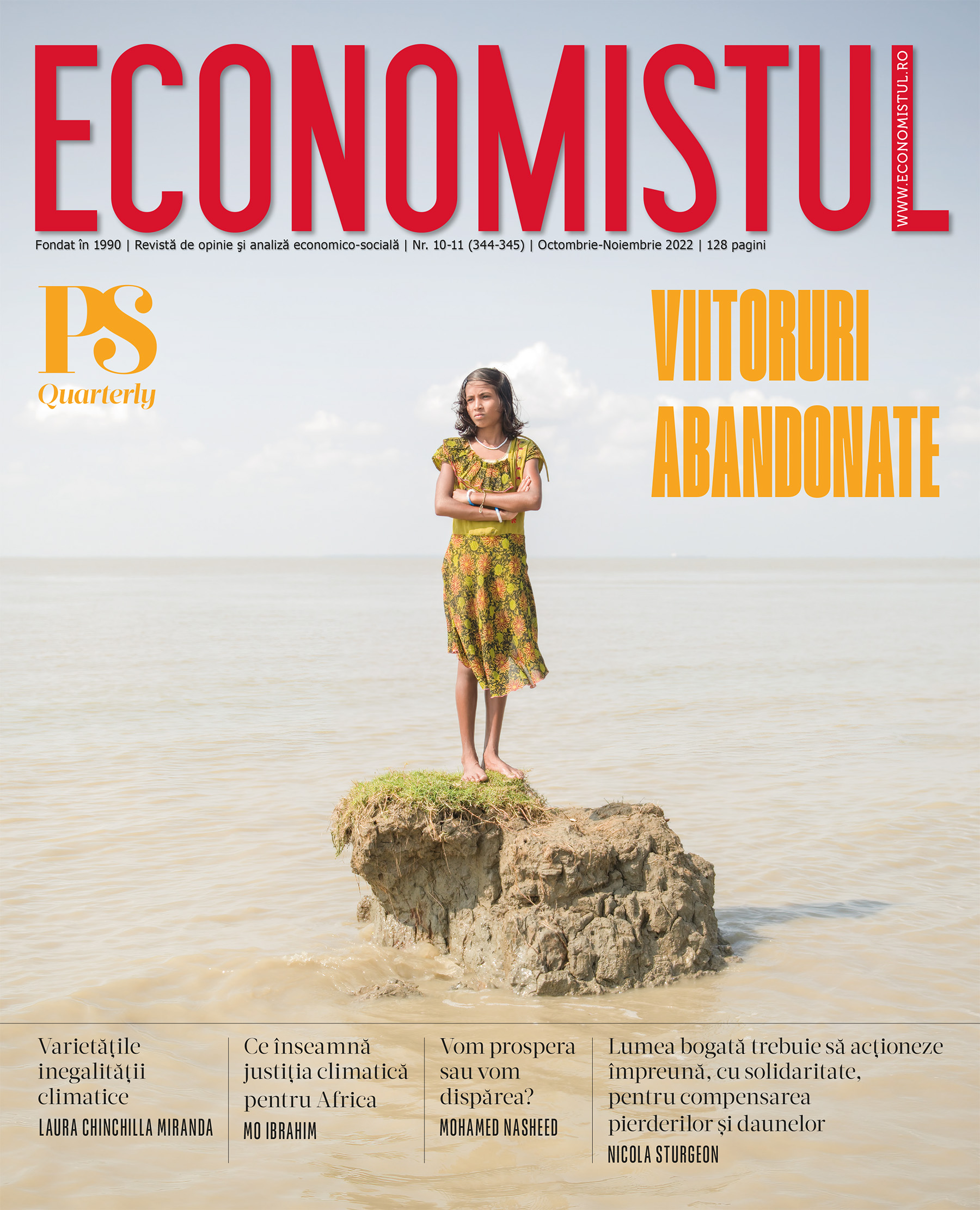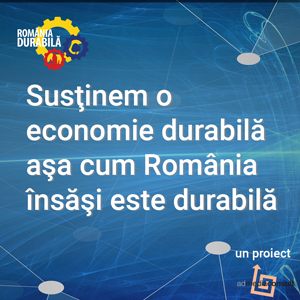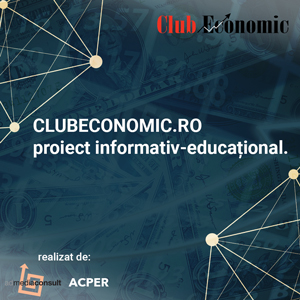Marius Bogdan PETRE a*, Andreea BACIU b, Dragos Daniel DENDRINO c,
Casandra Elena CEAUȘESCU d
a, b, c, d Bucharest University of Economic Studies, Romania
ABSTRACT
The insurance industry is in a transformative period driven by digitalization and artificial intelligence (AI). This study explores how AI technologies are integrated into the insurance sector, restructuring traditional processes such as underwriting, claims management, and customer service. Through bibliometric analysis, this research investigates trends, influential publications, and prominent authors, emphasizing the evolution of digital applications in the insurance sector. Key findings highlight the impact of AI on operational efficiency, risk assessment, and customer experience, as well as the increasing need for regulatory frameworks to manage data security and ethical concerns in AI-driven insurance processes.
KEYWORDS: artificial intelligence, digitalization, digital transformation, insurance.
DOI: 10.24818/IMC/2024/05.09
1. INTRODUCTION
The insurance industry has undergone profound transformations in recent decades, influenced by technological advances, including digitalization and the adoption of artificial intelligence (AI). Traditionally perceived as rigid and based on standardized rules, the insurance industry is evolving towards a dynamic and adaptable model capable of responding to the complex requirements of the modern global economy. The emergence of AI, defined as the ability of a system to correctly interpret external data, learn from it, and use it to perform specific tasks (Kaplan & Haenlein, 2018), has driven a fundamental shift in operational processes and the way customers interact.
The reconversion of the insurance system in this new technological context involves transformations in multiple areas, such as health, energy, logistics and cybersecurity. With numerous practical applications in insurance, artificial intelligence personalises customer experiences, detects fraud (Sun et al., 2016), and optimises underwriting processes (Maier et al., 2020; Nabrawi & Alanazi, 2023; Kaushik et al., 2022; Schmidt et al., 2017). At the same time, emerging technologies, such as blockchain, play a key role in creating a secure environment for storing and managing sensitive data (Wood et al., 2005).
This paper aims to analyze how AI and other advanced technologies can contribute to the resizing and reconversion the insurance system, highlighting the intersection between technological innovations and sustainability. Specifically, bibliometric analysis (Aria & Cuccurullo, 2017) provides insight into current trends in research, highlighting major directions, existing gaps, and international collaborations in this field (Passas, 2024).
* Corresponding author. E-mail address: petremarius23@stud.ase.ro
The evolution of research in this area reveals a significant increase in interest in the use of AI in insurance, with an annual publication growth rate of 15.05% in recent years. Studies indicate a trend towards integrating green technologies and sustainable solutions into electricity distribution systems and other associated sectors (Tietieriev, 2023). This underlines the importance of a cross-sectoral approach to support operational efficiency and global emission reduction targets (Bertin et al., 2019). Through this paper, we will answer the following research questions: How does digitalization influence the transformation of operational processes and interactions within the insurance system, and what role do AI technologies play in this process? What challenges and risks are associated with digitalization and AI adoption in this area? To what extent can advanced technologies support the transition to a sustainable and fair model?
Through this approach, we highlight the complex impact that AI has on the reconversion of the insurance system, contributing to a deeper understanding of its transformative potential and its long- term implications.
The bibliometric analysis aims to highlight the research areas in which the specialists’ efforts were mainly concentrated, the main topics addressed, and the research trend in the immediate period. The study is useful to both practitioners and theorists as a starting point for future research.
The paper is structured in four parts. The first part includes a brief review of the specialized works on the role of digitalization and the use of AI technologies in the transformation process of the insurance system. The second part describes the research methodology used to obtain relevant results. The third part contains the main results of the research, while the last part presents the conclusions, which highlight the main contributions of digitization and the use of AI in the insurance system, its implications, but also the limitations it has.
2. LITERATURE REVIEW
Once perceived as static and based on traditional rules, the insurance industry is undergoing a profound transformation under the influence of digitalization, artificial intelligence (AI) and the adoption of green technologies (He et al., 2024). These changes are closely linked to health (Rachmani et al., 2022), logistics (Wang et al., 2022), renewable energy (Gielen et al., 2019), finance (Shi et al., 2024), manufacturing, banking, insurance (Almagrabi et al., 2021), and cybersecurity (Østby & Kowalski, 2020), where technological innovation is redefining processes, products, and relationships between parties.
AI’s role in the insurance sector began gaining attention in the early 2000s, particularly in risk assessment (Weber & Staples, 2022), and fraud detection (Han et al., 2020). Early research emphasized the efficiency gains AI could bring to claims processing and fraud prevention by leveraging machine learning and predictive analytics ((Favaretto et al., 2019). However, it was only after the advent of big data that AI’s application in underwriting and customer experience management became feasible. Key areas where AI has significantly impacted the insurance sector include customer service automation (Kaur & Singh, 2023), fraud detection (Aslam et al., 2022), and dynamic pricing (Owens et al., 2022).
A notable example of the effects of digitalization is the reduction of adverse selection in property and casualty insurance. The digitization of data and its use for risk analysis allows for price optimization and service improvement, especially in areas with low social trust (Yang et al., 2024). Similarly, digital insurance platforms, such as those used for freight forwarding, improve customer access to personalized products, creating more efficient and relevant solutions (Yang et al., 2024). Cyber insurance is another emerging field in the context of digitalization. McGregor et al. (2023) highlight their importance in managing the risks associated with digital addiction and the challenges related to the lack of sufficient empirical research to understand this segment. Influenced by Industry 4.0, the insurance industry has adopted technologies such as blockchain and AI to facilitate processes, but operational risks remain a major concern (Srivastava et al., 2022).
In healthcare, AI and machine learning (ML) are essential in developing personalized health insurance. Neural network-based models, demonstrated 92.72% accuracy in predicting insurance premiums using parameters such as age, body mass index (BMI), and smoking habits (Wharam & Weiner, 2012). On the other hand, the digital health solutions introduced through the German DiGA program allow for the continuous evaluation of digital medical applications, marking a major shift in how innovations are managed and regulated (Gregor-Haack et al., 2021).
The digital transformation supports the uptake of renewables and the creation of sustainable systems in the energy sector. Smart grids allow for the optimization of consumption, the reduction of losses and the increase in the efficiency of using renewable resources (Arévalo & Jurado, 2024). Decentralized solutions, such as microgrids, support local communities, reducing reliance on centralized infrastructure and promoting energy equity (Tietieriev, 2023).
However, the digitalization of energy introduces security challenges, such as cyber vulnerabilities. Machine learning algorithms and blockchain provide solutions for detecting and preventing cyberattacks, helping to protect critical infrastructures (Wood et al., 2005). Moreover, integrating these solutions supports compliance with global emission reduction and green energy promotion targets.
The adoption of digital technologies in insurance and other fields is not without its challenges. Ethical issues like data protection and discrimination require flexible and adaptable policies (Martani et al., 2019). At the same time, regulatory issues related to the legal liability of digital platforms are complex but essential for effective implementation (Kiss & Fortier, 2015).
AI-driven tools assess individual risk factors with higher precision, offering tailored premium rates and improving the underwriting process. Machine learning algorithms can predict risk by analyzing vast historical data, which was previously challenging with traditional statistical methods. By automating claims processing, AI can detect patterns of fraudulent claims (Farao et al., 2023), reduce false payouts, and save insurers significant resources (Kirchner & Musshoff, 2024). Studies in digital transformation have shown that fraud detection rates improve considerably with AI’s predictive capabilities (Schmidt et al., 2017). The implementation of AI chatbots has automated initial customer interactions, allowing customers to access real-time information about their policies and claims status, enhancing customer satisfaction and retention (Paraskevi et al., 2023).
These technologies offer significant opportunities. Process automation reduces operational costs, and digitalization improves relationships between companies and customers (Orji & Ukwandu, 2023; Goundar et al., 2020; Srivastava et al., 2022; Yang et al., 2024).
The link between insurance, digital technologies, and sustainability is becoming more and more evident. Digitalization and AI are transforming traditional processes, introducing innovative solutions for risk management, and supporting the transition to a green economy. However, the success of these transformations depends on addressing regulatory, ethical, and security challenges (Omol, 2023). Adopting integrated strategies in health, energy, and logistics areas offers operational efficiency and a way to create a more sustainable and equitable future (Pappas et al., 2023). The adoption of AI in the insurance industry is part of a broader digital transformation that is reshaping the industry. Insurers are implementing AI-powered integration platforms to address their own set of integration challenges and enable more seamless digital transformation (Murthy et al., 2022). However, the successful implementation of AI and digital transformation in the insurance industry requires a holistic strategy that considers the various technological, organizational, and cultural aspects (Bohnert et al., 2018).
3. RESEARCH OBJECTIVES AND METHODOLOGY
This study aims to evaluate how AI technologies have influenced the insurance sector and identify research and application trends. For this, was used bibliometric analysis appreciated by the specialist for its efficiency, speed and accuracy of the data (Lim & Kumar, 2023; Raisins, 2024).
Bibliometric analysis uses data from the Web of Science databases (Pranckutė, 2021) to understand the scope and impact of AI in insurance. Tools such as biblioshiny, bibliometrix and RStudio (Moral- Muñoz et al., 2020) were used to process 3563 articles published between 1984 and 2024, identifying co-citations, authorship collaborations, and keyword trends that reveal the development and popular research themes in the digitalization of insurance processes.
The research process followed several stages. To search the data in the Web of Science database, after several tests considered unsatisfactory in terms of the number of results, the following query was used: „insurance*” AND „digital*”, which generated 3563 results from 1984 to 2024 inclusive. We included 2024 because it is close to the end, and the last search was conducted on November 15, 2024. The search was performed in all fields. The results were refined according to the type of papers, including only articles, proceeding papers, review articles, and early articles written in English. Following applying these inclusion criteria, we obtained 3,542 results, which were bibliometrically analyzed. The database was processed with RStudio software through the Biblioshiny interface. The data interpretation was performed based on the results generated with the help of the computer application.
4. RESULTS
In the first table, we have extracted the summary of the main results obtained from WoS, which has occurred over 40 years.
Table 1. Main information about the data
| Description | Results | DOCUMENT CONTENTS | Results |
| Timespan | 1984:2024 | Keywords Plus (ID) | 5015 |
| Sources (Journals, Books, etc) | 1981 | Author’s Keywords (DE) | 9793 |
| Documents | 3540 | Authors | 22028 |
| Annual Growth Rate % | 15.05 | Authors of single-authored docs | 301 |
| Document Average Age | 4.9 | Single-authored docs | 314 |
| Average citations per doc | 17.69 | Co-Authors per Doc | 10.4 |
| References | 125571 | International co-authorships % | 23.36 |
Source: Authors, retrieval from Bibliometrix based on WOS data
The analysis of this table highlights an increased interest in research in digitization, with an annual growth rate in the number of published documents of 15.05% over four decades (1984-2024). At the same time, international collaboration is significant, with a percentage of 23.36% for international co-authorship, while the average number of co-authors per document is 10.4, suggesting a strong trend of working in extended and interdisciplinary teams.
4.1 Article Production Over Time
Analyzing published articles on AI in insurance reveals significant growth, especially after 2016, when annual publications doubled yearly. This growth trend correlates with increased AI research and applications across sectors and the growing demand for data-driven solutions in insurance, especially post-pandemic.
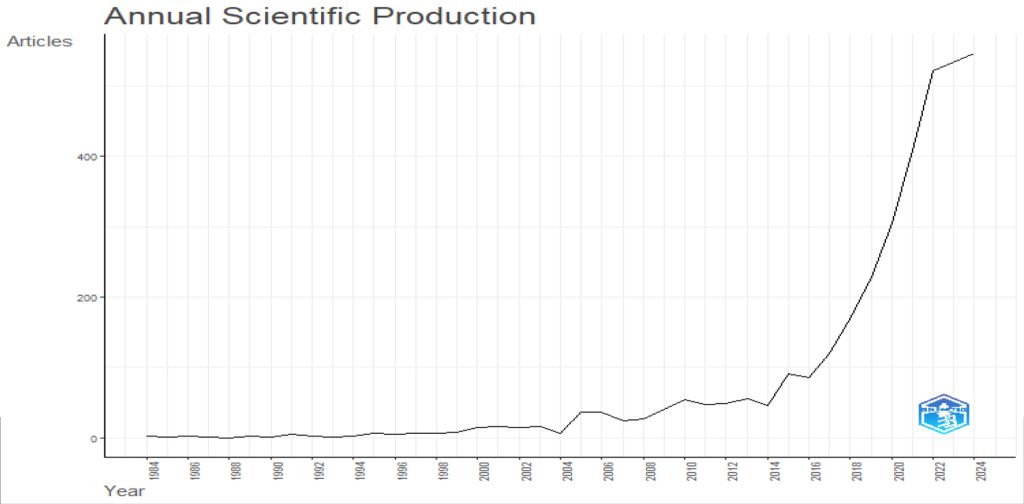
The analysis of this table highlights an exponential increase in the number of articles published over time, starting with a low volume of annual papers in the 80s and 90s. After 2015, there was a significant and steady increase in publications, culminating in a peak of 546 articles expected for 2024. This accentuated trend reflects the interest and expansion of research in the analyzed field, indicating a consolidation of the subject in the scientific literature, especially in the last decade.
4.2 Countries with the highest interest in research
Figure 2 illustrates the collaborations between the authors, the countries they come from and the institutions they are affiliated with. The list of authors connected to the countries of origin is on the left side in the middle of the chart. On the right side are the universities and institutions affiliated with each author.
ran, the US, and the UK are among the most representative countries, indicating intense research activity in international collaboration. At the same time, the most active institutions are Tehran University of Medical Sciences, University of London, and Harvard University, suggesting that they have a major influence and are central to the collaborative network. The network of research institutions includes universities from various world regions, including Europe, Asia, and Africa, reflecting a high degree of internationalization and geographical diversity in the interest in this research area. The figure also highlights the complexity and expansion of international academic collaborations in digitalization or other technological fields, with points of convergence in specific research centers.
4.3 Key publications and authors
Table 2 presents a ranking of authors based on the number of published articles and their fractional value, which suggests the extent of each author’s contribution to those publications.
Table 2: Most relevant authors
| Authors | Articles | Articles Fractionalized |
| SHIN DW | 84 | 10,1799173 |
| HAN K | 63 | 7,6751554 |
| LEE H | 28 | 3,25752187 |
| KIM YJ | 26 | 1,45600914 |
| JEONG SM | 25 | 3,05870518 |
| PARK JH | 25 | 3,67712843 |
| REZAEI N | 25 | 0,03922231 |
| KOWATSCH T | 24 | 4,66144689 |
| PARK J | 24 | 3,7861722 |
| KIM D | 23 | 2,56021658 |
Source: Authors, retrieval from Bibliometrix based on WOS data
The author with the highest number of articles is Shin DW, with 84 published articles, followed by Han K, with 63. These authors seem to be leaders in the field, having a significant volume of published works.
Split article analysis is a method of measuring the effective contribution of each author, considering multiple collaborations on a single article. The most prolific author of the articles is Shin DW, who has 84 articles with a fractional value of 10.18, which indicates that many of the articles are co- authored. His contribution is spread across multiple papers. In some authors, such as Rezaei N, there is a big difference between the total number of articles (25) and the fractional value (0.04). This suggests that although he co-authored many papers, his specific contribution is limited, probably due to collaboration in large teams. In contrast, Kowatsch T and Park J have relatively high fractional values, suggesting a significant and individual contribution in their articles, compared to other authors who may have more papers but smaller individual contributions.
The number of articles published by these authors has increased significantly in recent years. The most published authors, Shin DW, have prolific activity, especially in 2022 and 2023, which indicates an intensification of research in highly topical areas, such as public health and chronic diseases. In addition, Shin DW and Han K have articles with a high number of annual citations (TCpY), suggesting high academic interest and considerable influence on other researchers. Also, the frequency of articles published in high-impact journals, such as „Lancet”, „JAMA”, and „Scientific Reports”, underlines the quality and recognition of their work.
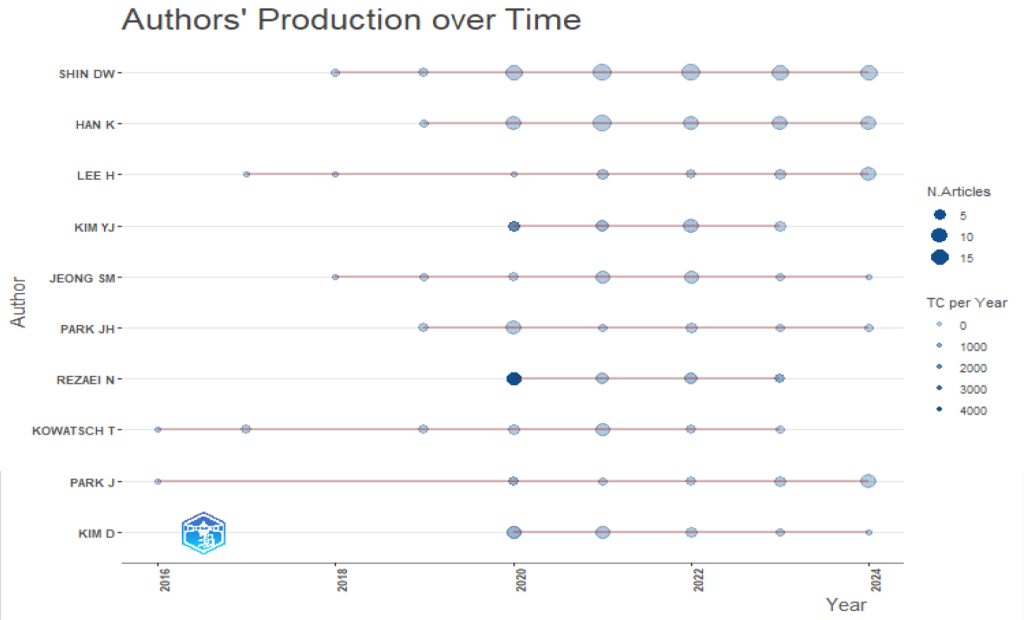
Source: Authors, retrieval from Bibliometrix based on WOS data
Temporal evolution shows a constant increase in academic activity, and the impact of these works indicates a considerable influence on the field, which places these authors among the essential contributors to the specialized literature.
4.4 National contributions and trends
The United States, China, and Germany have been leaders in research output and citations related to AI in insurance, contributing to technological advancements and regulatory considerations.
Table 3. Most cited country
| Country | TC | Average Article Citations |
| USA | 27986 | 37,2 |
| China | 5486 | 12,6 |
| Germany | 3818 | 10,3 |
| United Kingdom | 3214 | 30,9 |
| Korea | 2681 | 9 |
| Switzerland | 2115 | 25,5 |
| Finland | 1739 | 33,4 |
| Netherlands | 1565 | 24,8 |
| India | 1327 | 10,4 |
| Israel | 1222 | 81,5 |
Source: Authors, retrieval from Bibliometrix based on WOS data
The U.S. has five times as many citations as China, the next nation listed at the top of cited research, and 23 from Israel, the last at the top. Although it has only 1222 citations, Israel attracts attention with its average citations per article, which suggests the high quality and relevance of each published study.
Looking at Figure 4, we find that the most common terms are „digitalization” (161), „insurance” (133), „covid-19” (114), „digital health” (110) and „telemedicine” (106). The theme suggests a high interest in digitalization, health insurance, the development of the concept of digital health, and the increase in interest in technologies that are applied to health. The frequency, albeit moderate, of the keywords ‘blockchain’ (86) and ‘AI’ (70) shows that these technologies are the relevant ones, and the words ‘machine learning’ (69) and ‘health insurance’ (50), indicate a stable interest in machine learning and health insurance.
Analyzing the temporal evolution of the terms, we find that in 2019, „insurance” and „blockchain” were the main topics of attention in insurance and blockchain technology. Since 2020: „machine learning,” „digitalization,” and „health insurance” have sparked interest in digitalization and process automation. The year 2021 had „COVID-19,” „digital health,” „telemedicine”, and „AI” as its dominant topics, with the COVID-19 pandemic leading to a special interest in digital health, telemedicine, and AI. In 2023, the topics of major interest that continue to be relevant today were „digitalization,” „COVID-19,” „digital health,” „telemedicine,” „health insurance”, and „machine learning”. The year 2024 is dominated by „AI,” which indicates continued growth and predicted relevance of this field in the future. We, therefore, find that the pandemic has had a significant impact on health and technology research. The rise of digitalization and advanced technologies lies in the frequency of the words „digitalization,” „machine learning,” and „AI,” which suggest an important technological transformation with a constant evolution in the use of these technologies in various sectors. Also, the topics of „insurance” and „blockchain” show a trend of exploration of these areas since 2019, but also indicate that the use of this technology has reached the maturity phase. On the other hand, AI remains relevant and shows continuous growth, which is estimated to be an area of great interest in the coming period.
4.5 Thematic analysis of research areas
Analyzing the frequency of occurrence of the terms provides a clear picture of the current research’s theme and areas of interest (Figure 5).
The most common keywords are ‘risk’ (173) and ‘impact’ (152), which indicate a major interest in risk assessment and management and understanding the impact of deploying new technologies in health and industry. The following topics of interest are „management” (129) and „model” (115), which indicate an increased focus on the development and application of management models and organizational strategies. The strong interest in technological aspects and digital transformation is evidenced by the emergence of research topics from „technology” (81), „information” (80), „internet” (64), and „information technology” (38), and „big data” (31) and „telemedicine” (30) prove the increased interest in the use of big data and telemedicine, in the context of digitalization in health. These terms indicate researchers’ concern for adopting and integrating emerging technologies and how they affect the development of various fields, from health to business. Adopting digital technologies and the internet comes with data privacy and information security challenges, proven by the terms „privacy” and „trust”.
Figure 5 provides an overview of the evolution of terms and areas of interest in research between 1984 and 2025, from which it follows that „management” and „risks” are of continuous interest during the period after 2019, being associated with terms such as „impact”, „information”, „technology”, and „innovation”. Risks are mainly present in health, insurance, and medical services. „Challenges” is a common term in this period, being correlated with „risk”, which indicates the existence of obstacles and difficulties in addressing emerging risks related to implementing new technologies. „Insurance” emerged as a key term in 2022-2023, associated with „growth” and „system”, which indicates an expansion of the insurance market and a concern for insurance structures as a support for risk prevention and management.
Digital transformation is represented by terms such as „technology”, „information technology”, and „innovation”, which appear in associations with „management” and „impact”, suggesting an increase in the importance of digital technologies in optimizing management processes and assessing their impact in various fields. The orientation towards using big data and the methodological framework to support organizational decisions and risk analysis is also highlighted. In this context, the perception of innovation is becoming increasingly important in accepting and adopting emerging technologies. Terms such as „behaviour” and „association” show interest in analyzing behavioural factors.
„Power distribution” and terms associated with sustainable development, such as „green development” and „eco-friendliness”, prove the recent orientation towards sustainability in the context of energy distribution systems, revealing the importance of the energy transition and green technologies. These data reflect an evolution of research interest from traditional management and risk assessment (1984-2018) to a more holistic approach in the recent period, including digitalization, health, innovation, and sustainability. In 2022-2025, there is a strong focus on integrating advanced technologies, managing associated risks, and addressing inequalities in health and the sustainability of energy systems.
The coupling of documents according to their centrality led to the formation of four clusters: digital health, blockchain, COVID-19 and insurance (Figure 6).
The first cluster formed on digital health has the highest frequency (98), indicating the high interest of the field in literature and the connection with many other topics. The influence of the field is significant but not dominant compared to other themes.
The second cluster in which „blockchain” technologies are related to „AI”, „machine learning”, and „big data” has the lowest frequency (27) of the groups and the lowest centrality (0.32), which indicates a more limited interest in other topics, but with a specific niche in the research literature. However, it has the highest impact (3.8) of all groups, demonstrating a strong and potentially disruptive influence. Therefore, the blockchain and AI group is highly relevant for innovation, especially in big data and insurance, having a significant impact.
The third cluster, dedicated to public health, is of moderate interest and a moderate connection with other topics but has the least impact, which shows that its influence is short-lived.
The fourth cluster dedicated to insurance and digitalization has a close connection between „insurance” and „blockchain”, „digitalization”, and „digital transformation”. The high value of frequency (85) shows a high level of interest, and the moderate value of centrality (0.39) indicates that assurances are well connected with other topics with a notable impact (2.53), with significant importance and relevance in research. Therefore, insurance digitalization is of solid importance, greatly impacting the context of digital transformation and the adoption of new technologies in the insurance field.
4.6 Most Cited Articles
The ten most cited papers in the interest of insurance, presented in Table 4, reveal that they were created mainly during the pandemic period, the central theme being health and the use of digital technologies in the health field.
Table 4 Most Global Cited Documents
| Paper | DOI | Total Citations | TC per Year | Normaliz ed TC |
| MURRAY CJL, 2020, LANCET | 10.1016/S0140-6736(20)30752-2 | 6866 | 1373.2 | 124.19 |
| VOS T, 2020, LANCET-a | 10.1016/s0140-6736(20)30925-9 | 2832 | 566.4 | 51.22 |
| STEINMETZ JD, 2021, LANCET GLOB HEALTH | 10.1016/S2214-109X(20)30489-7 | 1524 | 381 | 63.47 |
| ONG KL, 2023, LANCET | 10.1016/S0140-6736(23)01301-6 | 821 | 410.5 | 117.88 |
| DOUTHIT N, 2015, PUBLIC HEALTH | 10.1016/j.puhe.2015.04.001 | 649 | 64.9 | 22.21 |
| LI X, 2017, LANCET | 10.1016/S0140-6736(17)33109-4 | 631 | 78.87 | 28.15 |
| KOEHLER F, 2011, CIRCULATION | 10.1161/CIRCULATIONAH A.111.018473 | 509 | 36.35 | 12.91 |
| NIEMI MEK, 2021, NATURE | 10.1038/s41586-021-03767-x | 505 | 126.25 | 21.03 |
| EBERLY LA, 2020, JAMA NETW OPEN | 10.1001/jamanetworkopen.20 20.31640 | 487 | 97.4 | 8.80 |
| NETER E, 2012, J MED INTERNET RES | 10.2196/jmir.1619 | 445 | 34.23 | 14.16 |
Source: Authors, retrieval from Bibliometrix based on WOS data
Koehler et al. (2011) highlighted that cardiovascular diseases generate significant costs for patients and healthcare providers, a significant part of which are covered by health insurance, reducing the financial burden on patients and facilitating access to modern treatments (Li et al., 2017; Steinmetz et al., 2020). Therefore, insurance is essential in integrating digital health into systems, so online access to medical information must be supported and regulated (Neter & Brainin, 2012). Without insurance, vulnerable groups, such as rural populations, face financial barriers limiting their healthcare access (Douthit et al., 2015). Murray et al. (2020) and Vos et al. (2020) consider that health insurance is essential to ensure the population’s accessibility to necessary medical services during the COVID-19 pandemic, concluding that health systems well supported by insurance policies have responded better to the crisis (Eberly et al., 2020).
5.CONCLUSION
The bibliometric analysis provided in this article reveals an exponential growth in academic interest in the intersection between artificial intelligence (AI) and the insurance industry. With a global presence of research and the involvement of numerous countries and leading academic institutions, it is evident that this intersection represents a transformative frontier for innovation. The increased focus on this topic in recent years highlights the rapid adaptation of the insurance sector and academia to technological advancements and global challenges.
Thematic analyses illustrate the evolution of AI in insurance, showcasing a shift from traditional risk assessment and fraud detection to interdisciplinary approaches incorporating advanced technologies such as blockchain and big data analytics. These advancements align with the global trends of digitalization and sustainability, emphasizing the role of AI in facilitating dynamic pricing, enhancing customer experiences, and promoting energy equity. Collaboration networks further demonstrate the value of international cooperation and knowledge exchange in advancing research in this field.
Regarding the limitations of this research, the exclusive use of the Web of Science (WoS) database may have excluded relevant works indexed in other databases, such as Scopus, or published in niche journals outside the WoS framework. Moreover, the focus on English-language publications might limit the global representation of research in AI and insurance, particularly from non-English- speaking regions. However, we believe these limitations have a minor impact on the conclusions’ validity, as the data analyzed provides a robust overview of the field.
As a primary direction for future research, we propose conducting a quantitative study to investigate the practical implementation of AI in insurance systems and its influence on operational efficiency and risk management. This study evaluates how AI-driven technologies, such as predictive analytics and dynamic pricing models, impact customer satisfaction and operational resilience in a rapidly digitalizing insurance landscape. Moreover, it will seek to identify significant differences in fraud detection rates, underwriting processes, and overall system efficiency pre and post-implementation of advanced AI systems.
This work bridges a critical gap in the specialized literature by providing a comprehensive bibliometric overview of AI impact on insurance. It establishes a foundation for further interdisciplinary research, emphasizing the importance of integrating AI into risk management, sustainability, and customer-centric processes. Practically, this study offers significant managerial implications for insurance leaders and policymakers. Insurers must adapt their operational frameworks to leverage AI technologies effectively, integrating digitalization strategies into underwriting, claims processing, and customer interaction models. Additionally, managers need to continuously monitor technological trends and invest in training staff to align with innovations in AI, ensuring that their organizations remain competitive in an evolving market. Finally, fostering international collaboration and aligning with global sustainability goals will be crucial for navigating the complexities and opportunities within this transformative industry.
ACKNOWLEDGEMENT
This study was carried out at the Doctoral School of Management at the Bucharest University of Economic Studies.
REFERENCES
- Blockchain-as- a-Utility for Next-Generation Healthcare Internet of Things. Computers, Materials & Continua, 68(1), 359–376
Almagrabi, A. O., Ali, R., Alghazzawi, D., AlBarakati, A., & Khurshaid, T. (2021) - Impact of artificial intelligence on the planning and operation of distributed energy systems in smart grids. Energies, 17(17), 4501
Arévalo, P., & Jurado, F. (2024) - bibliometrix: An R-tool for comprehensive science mapping analysis. Journal of Informetrics, 11(4), 959–975
Aria, M., & Cuccurullo, C. (2017) - Insurance fraud detection: Evidence from artificial intelligence and machine learning. Research in International Business and Finance, 62, 101744
Aslam, F., Hunjra, A. I., Ftiti, Z., Louhichi, W., & Shams, T. (2022) - Construction, deconstruction, reuse of the structural elements: the circular economy to reach zero carbon. IOP Conference Series Earth and Environmental Science, 323(1), 012020
Bertin, I., Lebrun, F., Braham, N., & Roy, R. L. (2019) - Digital agendas in the insurance industry: the importance of comprehensive approaches. The Geneva Papers on Risk and Insurance Issues and Practice, 44(1), 1–19
Bohnert, A., Fritzsche, A., & Gregor, S. (2018) - Exposing some important barriers to health care access in the rural USA. Public Health, 129(6), 611–620
Douthit, N., Kiv, S., Dwolatzky, T., & Biswas, S. (2015) - Patient characteristics associated with telemedicine access during the COVID-19 pandemic. JAMA Network Open, 3(12), e2031640
Eberly, L. A., et al. (2020) - INCHAIN: a cyber insurance architecture with smart contracts and self-sovereign identity. International Journal of Information Security, 23(1), 347–371
Farao, A., Paparis, G., Panda, S., Panaousis, E., Zarras, A., & Xenakis, C. (2023) - Big Data and discrimination: perils, promises and solutions. A systematic review. Journal of Big Data, 6(1)
Favaretto, M., De Clercq, E., & Elger, B. S. (2019) - The role of renewable energy in the global energy transformation. Energy Strategy Reviews, 24, 38–50
Gielen, D., Boshell, F., Saygin, D., Bazilian, M. D., Wagner, N., & Gorini, R. (2019) - Health insurance claim prediction using artificial neural networks. Int. J. of System Dynamics Applications, 9(3), 40–57
Goundar, S., Prakash, S., Sadal, P., & Bhardwaj, A. (2020) - Das neue Bewertungsverfahren zur Erstattung digitaler Gesundheitsanwendungen (DiGA). Bundesgesundheitsblatt, 64(10), 1220–1227
Gregor-Haack, J., Busse, T., & Hagenmeyer, E. (2021) - Anti-Fraud in international supply chain finance: Focusing on Moneual case
Han, K., Park, S. W., & Lee, S. (2020) - From resources to resilience: How green innovation, fintech and natural resources shape sustainability. Resources Policy, 91, 104856
He, B., Jie, W., He, H., Alsubih, M., Arnone, G., & Makhmudov, S. (2024) - The potential of eHealth for cancer patients during COVID-19. PLoS ONE, 18(2), e0280723
Holderried, T. A. W., et al. (2023) - Siri, Siri, in my hand: Who’s the fairest in the land? Business Horizons, 62(1), 15–25
Kaplan, A., & Haenlein, M. (2018) - Exploring the impact of InsurTech adoption in Indian life insurance industry. The TQM Journal
Kaur, P., & Singh, M. (2023) - Machine Learning-Based Regression Framework to predict health insurance premiums. IJERPH, 19(13), 7898
Kaushik, K., Bhardwaj, A., Dwivedi, A. D., & Singh, R. (2022) - Digital opportunities for the distribution of index-based microinsurance. Journal of Agricultural Economics, 75(2), 794–815
Kirchner, E., & Musshoff, O. (2024) - Ehealth in the Management of Chronic Diseases: A Review of Program efficacy. Value in Health, 18(3), A131–A132
Kiss, N., & Fortier, K. (2015) - Impact of remote telemedical management on mortality and hospitalizations in ambulatory patients with chronic heart failure. Circulation, 123(17), 1873–1880
Koehler, F., Winkler, S., Schieber, M., et al. (2011) - The primary health-care system in China. The Lancet, 390(10112), 2584–2594
Li, X., Lu, J., Hu, S., et al. (2017) - Guidelines for interpreting the results of bibliometric analysis: A sensemaking approach. Global Business and Organizational Excellence, 43(2), 17–26
Lim, W. M., & Kumar, S. (2023) - Improving the Accuracy and Transparency of Underwriting with AI. AI Magazine, 41(3), 78–93
Maier, M., Carlotto, H., Saperstein, S., et al. (2020) - Stay fit or get bit – ethical issues in sharing health data with insurers’ apps. Schweizerische Medizinische Wochenschrift
Martani, A., Shaw, D., & Elger, B. S. (2019) - Cyberspace and Personal Cyber Insurance: A Systematic review. Journal of Computer Information Systems, 64(1), 157–171
McGregor, R., Reaiche, C., Boyle, S., & De Zubielqui, G. C. (2023) - Software tools for conducting bibliometric analysis in science: An up-to-date review. El Profesional De La Informacion, 29(1)
Moral-Muñoz, J. A., Herrera-Viedma, E., Santisteban-Espejo, A., & Cobo, M. J. (2020) - Global burden of 87 risk factors in 204 countries and territories, 1990–2019. The Lancet, 396(10258), 1223–1249
Murray, C. J. L., et al. (2020) - AI-Powered Integration Platforms: A case study in retail and insurance digital transformation
Murthy, C. J., Rambabu, V. P., & Singh, J. T. S. (2022) - Fraud detection in healthcare insurance claims using machine learning. Risks, 11(9), 160
Nabrawi, E., & Alanazi, A. (2023) - EHealth Literacy: Extending the digital divide to the realm of health information. Journal of Medical Internet Research, 14(1), e19
Neter, E., & Brainin, E. (2012) - Organizational digital transformation: from evolution to future trends. Digital Transformation and Society
Omol, E. J. (2023) - Machine learning for an explainable cost prediction of medical insurance. Machine Learning With Applications, 15, 100516
Orji, U., & Ukwandu, E. (2023) - Preparing for cyber crisis management exercises. Lecture Notes in Computer Science, pp. 279–290
Østby, G., & Kowalski, S. J. (2020) - Explainable Artificial Intelligence (XAI) in insurance. Risks, 10(12), 230
Owens, E., Sheehan, B., Mullins, M., et al. (2022) - Investigating orthogonal and non–orthogonal rotation in factor analysis. Communications in Statistics – Simulation and Computation, 48(7), 2165–2176
Panaretos, D., Tzavelas, G., Vamvakari, M., & Panagiotakos, D. (2018) - Responsible digital transformation for a sustainable society. Information Systems Frontiers, 25(3), 945–953
Pappas, I. O., Mikalef, P., Dwivedi, Y. K., Jaccheri, L., & Krogstie, J. (2023) - Modeling Nonusers’ Behavioral Intention towards Mobile Chatbot Adoption. Human Behavior and Emerging Technologies, 2023, 1–16
Paraskevi, G., Saprikis, V., & Avlogiaris, G. (2023) - Bibliometric Analysis: the main steps. Encyclopedia, 4(2), 1014–1025
Passas, I. (2024) - Web of Science (WOS) and Scopus: the titans of bibliographic information in today’s academic world. Publications, 9(1), 12
Pranckutė, R. (2021) - Development and validation of digital health literacy competencies (DHLC). Computer Methods and Programs in Biomedicine Update, 2, 100082
Rachmani, E., Haikal, H., & Rimawati, E. (2022) - The Impact of digitization on information system design. Lecture Notes in Business Information Processing, pp. 137–149
Schmidt, R., Möhring, M., Bär, F., & Zimmermann, A. (2017) - Artificial intelligence Applications in Health care Practice: Scoping review. Journal of Medical Internet Research, 24(10), e40238
Sharma, M., Savage, C., Nair, M., Larsson, I., Svedberg, P., & Nygren, J. M. (2022) - Green finance, investor preferences, and corporate green innovation. Finance Research Letters, 66, 105676
Shi, R., Zhou, H., Li, X., Miao, X., & Zhao, X. (2024) - Insurance in the Industry 4.0 environment: A literature review, synthesis, and research agenda. Australian Journal of Management, 49(2), 290–312
Srivastava, R., Prashar, A., Iyer, S., & Gotise, P. (2022) - Causes of blindness and vision impairment in 2020 and trends over 30 years. The Lancet Global Health, 9(2), e144–e160
Steinmetz, J. D., Bourne, R. R. A., Briant, P. S., et al. (2020) - A Hybrid Approach for Detecting Fraudulent Medical Insurance Claims (Extended Abstract)
Sun, C., Shi, Y., Li, Q., Cui, L., Yu, H., & Miao, C. (2016) - Smart Grid integration for Sustainable city energy Management. Lighting Engineering & Power Engineering, 62(1), 1–11
Tietieriev, V. (2023) - Decoding the algorithmic operations of Australia’s National Disability Insurance Scheme. Australian Journal of Social Issues
Van Toorn, G., & Carney, T. (2024) - Implementing additive manufacturing in orthopedic shoe supply chains—Cost and lead time comparison. Logistics, 8(2), 49
Verboeket, V., Krikke, H., & Salmi, M. (2024) - Global burden of 369 diseases and injuries in 204 countries and territories, 1990–2019. The Lancet, 396(10258), 1204–1222
Vos, T., Lim, S. S., Abbafati, C., et al. (2020) - Do transportation taxes promote pro-environmental behaviour? Environmental Science and Pollution Research, 30(13), 35545–35553
Wang, L., Chen, Z., Mahmood, M. T., et al. (2022) - Financial accessibility and crime – Empirical study based on panel data from Chinese cities. Kybernetes
Wang, Z., Ye, D., & Liang, T. (2023) - Programmable money: next-generation blockchain-based conditional payments. Digital Finance, 4(2–3), 109–125
Weber, I., & Staples, M. (2022) - The promise and peril of healthcare forecasting. Johns Hopkins University
Wharam, J. F., & Weiner, J. P. (2012) - Catastrophe loss modelling of storm-surge flood risk in eastern England. Philosophical Transactions of the Royal Society A, 363(1831), 1407–1422
Wood, R. M., Drayton, M., Berger, A., Burgess, P., & Wright, T. (2005) - Digitalisation and cream skimming adverse selection in the property-casualty insurance industry: evidence from China. The Geneva Papers on Risk and Insurance
Yang, F., Ren, J., & Xia, C. (2024)


